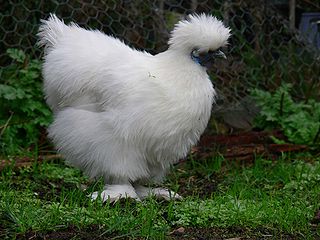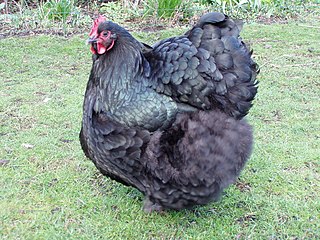
Poultry are domesticated birds kept by humans for their eggs, their meat or their feathers. These birds are most typically members of the superorder Galloanserae (fowl), especially the order Galliformes. The term also includes birds that are killed for their meat, such as the young of pigeons but does not include similar wild birds hunted for sport or food and known as game. The word "poultry" comes from the French/Norman word poule, itself derived from the Latin word pullus, which means small animal.

The Silkie is a breed of chicken named for its atypically fluffy plumage, which is said to feel like silk and satin. The breed has several other unusual qualities, such as black skin and bones, blue earlobes, and five toes on each foot, whereas most chickens only have four. They are often exhibited in poultry shows, and appear in various colors. In addition to their distinctive physical characteristics, Silkies are well known for their calm, friendly temperament. It is among the most docile of poultry. Hens are also exceptionally broody, and care for young well. Though they are fair layers themselves, laying only about three eggs a week, they are commonly used to hatch eggs from other breeds and bird species due to their broody nature.

The Orpington is a British breed of chicken. It was bred in the late nineteenth century by William Cook of Orpington, Kent, in south-east England. It was intended to be a dual-purpose breed, to be reared both for eggs and for meat, but soon became exclusively a show bird.

A comb is a fleshy growth or crest on the top of the head of gallinaceous birds, such as turkeys, pheasants, and domestic chickens. Its alternative name cockscomb reflects that combs are generally larger on males than on females. There can be several fleshy protuberances on the heads and throats of gallinaceous birds, i.e. the comb, wattle, and earlobe, which collectively are called caruncles, however, in turkeys caruncle refers specifically to the fleshy nodules on the head and throat.

The Serama, also called the Malaysian Serama, is a bantam breed of chicken originating in Malaysia within the last 50 years.

The Japanese Bantam or Chabo is a Japanese breed of ornamental chicken. It is a true bantam breed, meaning that there are no large fowl counterparts. It characterised by very short legs and a large upright tail that reaches much higher than the head of the bird.
The Minorca, Catalan: Gallina de Menorca, Spanish: Menorquina, is a breed of domestic chicken originating in the Mediterranean island of Menorca, in the Balearic Islands to the south-east of Spain. It is a well-known exhibition bird in many countries of the world, but in the island of Menorca is an endangered breed and considered to be at risk of extinction.

The Sebright is a British breed of bantam chicken. It is a true bantam – a miniature bird with no corresponding large version – and is one of the oldest recorded British bantam breeds. It is named after Sir John Saunders Sebright, who created it as an ornamental breed by selective breeding in the early nineteenth century.

The Buckeye is a breed of chicken originating in the U.S. state of Ohio. Created in the early 19th century, Buckeyes are the only standard breed recognized by the American Poultry Association (APA) that is known to have been developed by a woman. It is the only breed in the American Class to have a pea comb. Buckeyes are listed as "Watch" by The Livestock Conservancy. The breed's name is derived from Ohio's nickname of "Buckeye state". Their mahogany color is said ideally to resemble the seeds of the Ohio Buckeye plant. They are a dual-purpose chicken, known both for laying productivity and meat characteristics. Buckeyes are yellow-skinned chickens that lay brown eggs.

The Dutch Bantam is a breed of bantam chicken originating in the Netherlands. It is a true bantam, a naturally small bird with no related large fowl from which it was miniaturized. It is kept mainly for exhibition, and has been bred in many color varieties; it is a good layer of small eggs.

The Modern Game is a breed of ornamental chicken which originated in England between 1850 and 1900. Purely an exhibition bird, Modern Game were developed to be most aesthetically pleasing and to epitomize the visual appeal of the gamecock or fighting cock.
The Nankin Bantam or Nankin is a British bantam breed of chicken. It is a true bantam, a naturally small breed with no large counterpart from which it was miniaturised. It is of South-east Asian origin, and is among the oldest bantam breeds. It is a yellowish buff colour, and the name is thought to derive from the colour of nankeen cotton from China.
The Marsh Daisy is a rare breed of chicken originating in Lancashire, England. Its name may be related to its origin in a marsh-like area, or that its large rose comb resembles the flower of the Marsh Daisy.

The Barbu d'Anvers, Dutch: Antwerpse baardkriel, is a breed of bantam chicken from Belgium. It is a true bantam, and has no full-sized counterpart; males weigh about 700 grams and hens about 600 g. The Barbu d'Anvers is one of the oldest bantam breeds, and is thought to have originated in the province of Antwerp in northern Flanders. It is the only Belgian bantam breed not threatened with extinction. In the United States it may be called the Antwerp Belgian or Belgian Bearded d'Anvers.

The Sultan is a breed of chicken originating in Turkey, belonging to the group of crested chicken. Its English moniker is directly culled from the original Turkish language name of Serai-Tavuk, which translates as "fowls of the Sultan". They have always been primarily ornamental, having been kept in the gardens of Ottoman sultanate. In the West they are bred for competitive showing as part of poultry fancy, and are generally a rare sight.
The Iowa Blue is a breed of chicken that originated near Decorah, Iowa in the early 20th century. Despite its name, the breed is not actually blue according to poultry standards. It is an exceedingly rare fowl, and is not recognized for showing by the American Poultry Association. They are a dual-purpose breed laying brown eggs and known to be good foragers.

The Derbyshire Redcap is a breed of chicken originating in the English county of Derbyshire. The name "Redcap" derives from the breed's unusually large Rose-type comb. British breed standards dictate a length of more than 7 centimetres (3 inches) of length for a Redcap comb. It is covered in small, fleshy points, and has a distinct spike pointing backwards called a "leader". Combs, wattles and earlobes are all ideally bright red.

The Scots Grey is a dual-purpose breed of domestic chicken originating in Scotland, where it has been bred for more than two hundred years. It was formerly known as the Scotch Grey and until about 1930 was popular in Scotland. It is on the "Native Poultry Breeds at Risk" list of the Rare Breeds Survival Trust.
All chicken breeds recognized by the American Poultry Association are categorized into classes. Standard-sized breeds are grouped by type or by place of origin; bantam breeds are classified according to type or physical characteristics.














